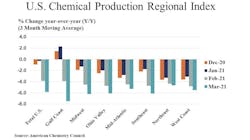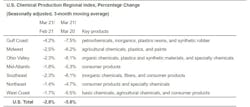The U.S. Chemical Production Regional Index (U.S. CPRI) fell 2.8% in March following a 3.9% decline in February and a 0.6% increase in January, according to the American Chemistry Council (ACC).
Chemical output fell in all regions as the impact of the February winter storm continued to disrupt chemical production in the Gulf Coast and parts of the country that rely on raw materials from the region, ACC said.
The U.S. CPRI is measured as a three-month moving average (3MMA) basis.
The index showed chemical production was mixed in March, with improvement occurring in the production of chlor-alkali, adhesives, coatings, other specialties, manufactured fibers, synthetic rubber, and fertilizers. These gains were offset by continued weakness in organic chemicals, plastic resins industrial gases, synthetic dyes and pigments, other inorganic chemicals, crop protection chemicals and consumer products.
As nearly all manufactured goods are produced using chemistry in some form, manufacturing activity is an important indicator for chemical demand. After declining in March, manufacturing output edged 0.1% higher in April. The trend in manufacturing production was mixed with gains in the output of food and beverages, appliances, aerospace, construction supplies, machinery, fabricated metal products, computers and electronics, semiconductors, refining, foundries, rubber products, structural panels, textile product mills, apparel, and furniture.
Compared with March 2020, U.S. chemical production remained off by 5.8% on a year-over-year basis, the 22nd consecutive month of year-over-year declines, and a deterioration reflecting the lingering impact of the winter storms. Chemical production was lower than a year ago in all regions.
The chemistry industry is one of the largest industries in the United States, a $565 billion enterprise. The manufacturing sector is the largest consumer of chemical products, and 96% of manufactured goods are touched by chemistry. The U.S. CPRI was developed to track chemical production activity in seven regions of the United States. The U.S. CPRI is based on information from the Federal Reserve, and as such, includes monthly revisions as published by the Federal Reserve. To smooth month-to-month fluctuations, the U.S. CPRI is measured using a three-month moving average. Thus, the reading in March reflects production activity during January, February, and March.

